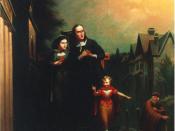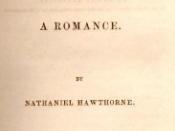Hester"ÃÂthe Heroine The heroine in the Scarlet Letter is Hester Prynne. Even though Hester sins against God, she is a woman who survives the horrendous trials of a "Puritan"ÃÂ society"ÃÂthe society that wants to be a Utopia among imperfect people. From her horrendous trials, Hester gains strength, courage, and her lost love.
The story begins when Hester appears from the darkness of a rusted jail cell into the stale, damp summer morning. In her arms, she cradles the product of her sin"ÃÂPearl. Hester Prynne is a woman accused of committing adultery. Adultery is considered a grave sin among a Puritan society"ÃÂUtopia. Since Hester sinned against God, the magistrates"ÃÂjudges, decide to condemn Hester from paradise (Carpenter, 285). This means that Hester would not be considered a Puritan. On the other hand, Hester does not care about the judgement of the magistrates. Instead, she knows that God will judge her.
As a sign of her sin, the magistrates use the letter A as a living sermon against sin (Carabine, 157).
They know that this letter will suppress Hester's rebellious passion because it threatens their civil system (Bell, 152). The scarlet letter A does not serve its purpose, and it does not suppress Hester from the Puritan society. The first thing Hester does is that she enlarges the letter A for everyone to see on her bosom. Instead of making the "A"ÃÂ a simple letter, she embroiders the letter with intricate designs of gold. The townspeople are in awe. They have never seen needlework done in that fashion. The scarlet letter is like an illumination of light that glows like a flashlight for the solemn society of New England. When you think of a flashlight shining against darkness, it is very narrow. The narrow perception of light represents the narrow-minded Puritans.
Barber 2 Hester wants to show the scarlet letter, light, to everyone. By doing this, she wants to let people know that all people sin. Hawthorne said, ""æif truth were everywhere to be shown, a scarlet letter would blaze forth on many a bosom besides Hester Prynne"æ."ÃÂ(Scarlet Letter, 78). A man by the name of Randall Stewart from the Nineteenth-Century Literature Criticism has this to say about the scarlet letter: Hester is a romantic heroine, a splendid one. She has been much admired, and justifiably. The richly embroidered A has been called by one of her modern admirers "the red badge of courage."à(298) Hester surely shows courage, especially during the first scaffold scene. For three long hours, Hester does not succumb to the mockery and persecution of the people. The magistrates can not kill her because they are not certain if Hester's husband is still alive. The magistrates finally get tired of waiting for Hester's confession. Therefore, they inform Dimmesdale to ask for her confession. Of course, Dimmesdale is nervous. In actuality, he is the father of the infant, Pearl. After Dimmesdale asks Hester to confess, she still does not tell the townspeople. She remains loyal to her lover.
After the three hour trial, Hester is sent back to jail. The next day, she is released. Hester has to decide if she wants to stay in New England. She can leave the country and hide her shame, or she can stay in New England and face her punishment. Hester decides to stay and face her punishment. Her punishment is not her only reason of staying in New England. She is in love with Dimmesdale, and she does not want to leave him.
As time progresses, Hester accepts her conflict"ÃÂexternal, with the Puritan society because she knows that she is an outcast. The townspeople mock her by calling her names. In today's society, they may call her a whore, slut, and other vulgar words.
Barber3 While the adults mock Hester, the Puritan children jeer at Pearl"ÃÂHester's daughter. Also, Hester is expelled from the church"ÃÂthe holy and sacred place. The religious leaders do not want Hester to corrupt the minds of the "sinless"ÃÂ Puritan congregation.
Since Hester is an outcast, she is fortifying against society. In a sense, she is becoming stronger. On the other hand, Dimmesdale has an internal conflict with himself. He knows that he is idolized by the community since he is being considered as second to God. As a result, Dimmesdale is fighting against himself. Since Dimmesdale is becoming weak, Hester is forced to become stronger. Dimmesdale gains his strength by contact with her strength when they meet in the forest (Waggoner, 292). This love for Dimmesdale is like fuel that fortifies her courage.
Even though Hester is fortified by the love for Dimmesdale, she is still punished by her daughter, Pearl. Hester has to not only survive the trials of the townspeople, but she has to survive the tests of Pearl. Pearl is a constant reminder of the sin, adultery. At times, Hester looks upon her child as an elf. Day by day, Hester looks into Pearl's expanding nature; ever dreading to detect some dark and wild peculiarity that should correspond with the guiltiness to which she owes her being (Scarlet Letter, 80). As a mother, Hester, tries to discipline Pearl. Unlike the Puritan families, Hester does not discipline her child with harsh rebukes, frowns, or spankings. Instead, Hester decides to show affable, but strict, control over her daughter. This discipline method does not work for Pearl. Even though Hester has fortified herself against the townspeople, she succumbs to the misfortunes from Pearl. However, she still thinks that Pearl is a miracle"ÃÂa gift from God. The gift allows Hester to stay alive.
As time passes, the lonely, single mother begins to do good deeds towards the townspeople. Hester uses her art of sewing in order to suppress the burning passion of Barber 4 love within her. She sews for the governor, military, and ministers. She also gives clothes away to the poor, but the poor mock her. They think that they are better than Hester. The committing of a sin is considered to be the lowest form of social standards. Hester humbly accepts the mocking. After seven years of disgrace, Hester is able to win the respect of her fellow-townsmen by her good deeds (Fogle, 288).
After seven years of raising Pearl alone, Hester decides that Pearl should get to know her father, Dimmesdale. Before Hester talks to Dimmesdale, she goes and talks with Chillingworth"ÃÂher husband, the man she never loved. In the Scarlet Letter, Chillingworth is an important character. Hester goes through Chillingworth, the evil villain, in order to get to Dimmesdale. For approximately seven years, Chillingworth has been plotting revenge on Dimmesdale. Chillingworth's devilish smile can not fool Hester. For her boldness, Hester tells Chillingworth that he will no longer be concealed as her husband.
As the story goes, Hester tells Dimmesdale about Chillingworth. Dimmesdale becomes stronger, and the both of them decide to leave New England after the Election Sermon. This moment in time is the moment Hester awaits"ÃÂthe moment to be with her lover. After seven long years of loneliness, Hester's soul is finally amended.
After the Election Sermon, Dimmesdale becomes weak again. His troubled heart weakens him, and he finally dies. Hester is not really saddened by Dimmesdale death. In a sense, Hester has actually gained her lost love from her courage and strength"ÃÂthe motive of her staying in New England. Hester knows that she will have an everlasting and pure reunion with Dimmesdale in the future"ÃÂafter she dies.
Barber 5 After the death of Dimmesdale, Hester and Pearl decide to go back to England. There, Pearl marries and lives a happy life. Hester, on the other hand, comes back to New England. Upon her return, Hester places the scarlet letter A back on her bosom.
The letter A is what defines her being"ÃÂher soul. From Hester's experience many people give her due respect. The Scarlet Letter states, ""æpeople brought all their sorrows and perplexities, and besought her counsel,"ædemanding why they were so wretched, and what the remedy"à(227).
Hester Prynne is indeed a heroine. She brings about change in the Puritan society; she faces her battles of persecution; she rises from the line of moral value to the sister of mercy; and she proves that the Utopia of the Puritans can not have jails among "perfect people"ÃÂ. Nina Baym from the Nineteenth-Century Literature Criticism states: Hester has in fact brought about a modest social change.
Society expands to accept her with the letter"ÃÂthe private life carves out a small place for itself in the community's awareness. This is a small, but real, triumph for the heroine. (313) Barber 6 WORKS CITED Bell, Michall D. "Nathaniel Hawthorne."ÃÂ Nineteenth-Century Literature Criticism. Ed. Janet Mullane. 17 vols. Detroit: Gale Research Inc, 1988.
Carpenter, Frederic I., et. al. "Nathaniel Hawthorne."ÃÂ Nineteenth-Century Literature Criticism. Ed. Laurie L. Harris. 10 vols. Detroit: Gale Reseach Inc, 1985.
Cunliff, Marcus. "Nathaniel Hawthorne."ÃÂ Nineteenth-Century Literature Criticism. Ed. Joann Cerrito. 39 vols. Detroit: Gale Research Inc, 1993.
Hawthorne, Nathaniel. The Scarlet Letter. New York: Viking Penquin Inc, 1983.
Janssen, James G. "Nathaniel Hawthorne."ÃÂ Short Story Criticism. Ed.
Sheila Fitzgerald. 3 vols. Detroit: Gale Research Inc, 1989.





